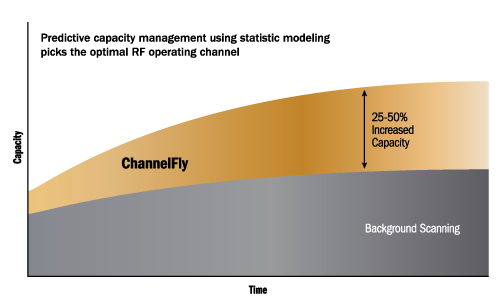
ChannelFly
Predictive Capacity Management for Smarter RF Channel Selection
ChannelFly is a new approach to dynamic channel management. Most enterprise- or carrier-class WLAN vendors, RUCKUS included, have for some time now offered the ability to change an AP's channel automatically within either the 2.4 or 5 GHz bands when interference or contention conditions warrant it. Sensing that the channel an AP is using with its currently attached clients has become degraded is the easy part. Deciding which channel to switch to is much harder.
Our new innovations in this area have been driven specifically by lessons learned in carrier Wi-Fi engagements, where APs are required to deliver good capacity in highly contentious public settings where channels are very busy. We started from the basic observation that changing channels makes sense only when you have some confidence that the target destination channel will improve capacity in practice - an assessment that cannot be accurately made based on spectrum analysis (based on energy levels) alone, given the nature of contention in a Wi-Fi context. Our new and unique approach involves assessment across all available channels, based on actual realizable capacity, before making any decisions about changes. The net result has been observed in trials on large-scale carrier networks to be multiple-fold improvements in AP and overall network capacity in the most challenging situations.
ChannelFly benefits include:
- Pre-shared encryption keys
- Leverages patented principles from BeamFlex™ to learn and select the best RF channel
- Uses live channel activity to learn what channels will yield the most throughput
- Assesses true channel capacity, not subjective noise and traffic measurements
- Works with 2.4 GHz access and 5 GHz backhaul
- System constantly determines proper channel; no configuration or monitoring necessary
- Fast reaction (in seconds) to significant drop in throughput
- Significant capacity improvement observed in congested environments (25 -50%)
 RUCKUS' innovative approach to channel
RUCKUS' innovative approach to channel
ChannelFly is an new approach to optimizing RF channel selection based on capacity averages across all channels. Specialized algorithms select the best channel based on historical values.
In combination with RUCKUS' adaptive antenna technology, ChannelFly delivers unprecedented throughput. When combined with RUCKUS' smart adaptive antenna array (BeamFlex), up to twice the capacity as competitive alternatives is achievable.
Network capacity is broadly defined as the maximum speed or rate that can be accommodated within a given link. In the case of your wireless network, this translates into throughput over time - the most important measure of the performance of any Wi-Fi network.

RUCKUS has already developed a patented approach to mitigating interference using adaptive antenna array technology (See Beamforming paper). With BeamFlex interference mitigation can be significantly enhanced through smarter and more dynamic channel selection techniques.
Poor Wi-Fi performance can be caused by interference on the same RF channel as the WLAN. Theoretically, changing the channel to an "interference free" selection will increase performance. While channel selection to avoid interference is not new, the majority of vendor implementations are rudimentary at best.
Virtually all wireless equipment suppliers who tout their interference avoidance capabilities use a technique called background scanning. With background scanning, the AP hops off of the channel and checks every other possible channel for potential interference.
A significant problem with background scanning is so-called "dead time." Dead time occurs when the AP is not on the same channel as its associated clients. If a client wants to transmit while an AP is performing a background scan it will have to wait. This technique is inefficient, at best. Interference characterization is not a high performance approach since it focuses on interference rather than capacity. Potential channel capacity cannot be quantified with this approach. Something new is needed.
Because capacity is the most important factor to determine performance, the effectiveness of channel-based interference mitigation must be measured by capacity rather than interference. RUCKUS has taken a different approach to this problem. Instead of "channel based interference mitigation based on interference characterization," RUCKUS focuses instead on capacity measurements over time.
A smart software engine, called ChannelFly, is integrated within each RUCKUS access point. ChannelFly monitors the RF environment constantly. It builds and maintains a trending history of the capacity and interference on every channel. If a significant drop in capacity occurs on the current channel, ChannelFly can quickly react and switch to a better channel in less than 15 seconds. For smaller capacity fluctuations, ChannelFly will take longer to react, avoiding unnecessary channel changes.
ChannelFly uses the 802.11h protocol, which is supported by many 2.4GHz and all 5GHz clients, to advertise the channel move to active clients when the channel change is necessary. This channel change announcement ensures smooth transitions from one channel to another channel for clients and access points.
ChannelFly is now available on all RUCKUS APs. Through early trials in a number of service provider and hospitality networks, ChannelFly has demonstrated up to three-fold improvements in overall AP capacity in highly contested environments.
Features and Benefits:
- Leverages patented principles from BeamFlex™ to learn and select the best RF channel
- Uses live channel activity to learn what channels will yield the most throughput
- Assesses true channel capacity, not subjective noise and traffic measurements
- Evaluates all channels: 2.4 GHz access and 5 GHz backhaul
- Smooth client transitions using 802.11h
- System constantly determines proper channel; no configuration or monitoring necessary
- Fast reaction (in seconds) to significant drop in throughput
- Significant capacity improvement observed in congested environments(25 -100%)
FL Channel:
Competitive approaches to RF channel selection go off-channel to passively listen for beacons, CRC errors and other metrics at a given moment in time. In contrast, ChannelFly constantly learns about each channel's capacity using actual activity on across all channels within the 2.4 and 5GHz bands. With this information, ChannelFly builds a statistical model over time to determine what channel will yield the greatest capacity for clients.

Documentation:
Download the RUCKUS ChannelFly Datasheet (PDF).

